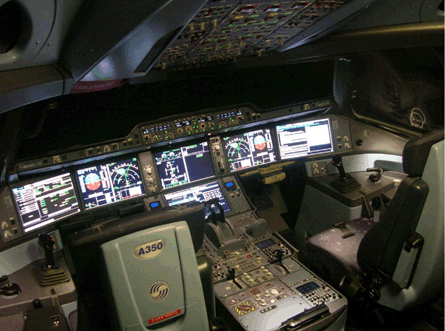Airbus is undertaking intensive testing of A350 XWB systems across its various plants as part of the ongoing development effort to ensure a high level of equipment maturity ahead of the twinjet's first flight a little over two years from now.
The XWB's systems development is following a similar programme to that of the A380, with cockpit mock-ups, integration benches and "Aircraft -1", "Aircraft 0" and "Cabin 0" test platforms being used by engineering teams ahead of the construction of the first flight-test aircraft.
Airbus has just completed the "Class 2" mock-up of the A350's cockpit, which will be used to hone the flightdeck layout while the Aircraft -1 development simulator is helping to fine-tune control laws.
 |
|---|
© Airbus |
"We've had a Class 1 mock-up, but this didn't have real components in it," says A350 chief engineer Gordon McConnell. "The Class 2 mock-up has all the prototypes of the final equipment, so it's got real controls, and a real overhead panel, which we've not had before. It allows us to work on the final tuning of the pilot interface, lighting balance and ergonomics."
For the last year, Airbus engineers have been using the A350's Aircraft -1 simulator in Toulouse, which incorporates some prototype hardware and software models for various systems such as flight control architectures for some 300h of testing.
The Aircraft -1 platform is a complete cockpit built into one of the A380 simulators which, other than the windshield shapes, is representative of the A350's flightdeck. "It has real displays, flight control laws, and a vision system, so we can actually fly the aeroplane," says McConnell. "This has enabled us to do a lot of important testing, such as the examination of handling qualities with flight control system failures, to validate the control laws."
The next phase of systems ground-testing will be undertaken on the Aircraft 0 integration simulators and iron-bird hydraulic/flight control system test rig. Construction is now underway in Toulouse and it is due to become operational towards the end of the year.
 |
|---|
© Airbus |
"One of the main purposes of the mechanical part of the rig is to carry out endurance testing the hydraulic system for certification purposes," McConnell says. "But we can also link it to the Aircraft 0 cockpit simulator, which allows us to 'fly' the aeroplane and exercise all the hydraulic and electrical systems as if they're on the aircraft."
Another important A350 "zero-test" item is what Airbus calls the "Cabin 0 V&V (verification and validation) platform" in Hamburg, says McConnell. The mock-up, dubbed "MSN5011", is 37m (121ft) long and comprises fully equipped fuselage sections 11/12 (nose), 13/14 (forward) and 16/18 (aft), with three passenger doors on each side and the three cargo hold hatches. It will be fully furnished with seats, lining and monuments in a layout based on the arrangement of the A350 cabin flight-test aircraft MSN002.
"The cabin can be linked to functional system integration benches, such as the air system - to look at air distribution - or the IFE system," says McConnell. "This will enable us to achieve a good standard of maturity before we fly our first furnished aircraft, MSN002."
Source: Flight International























